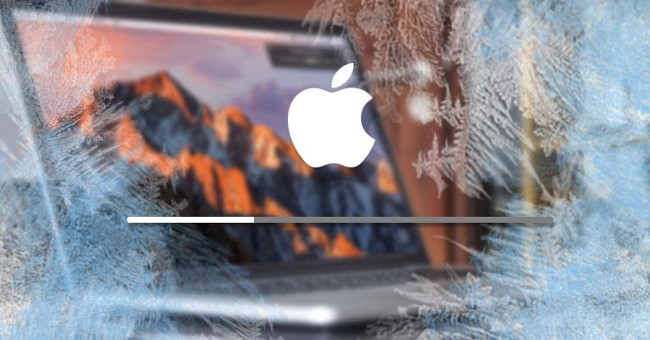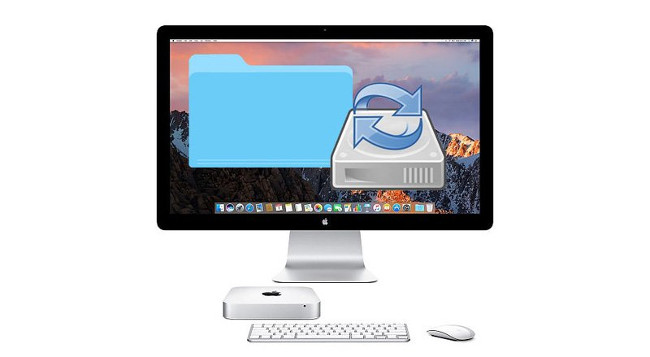Fix the Mac crashed during macOS update
After improving and changing some features on the Beta version, the final version (the final version) of macOS Sierra 10.12 was also released by Apple. The upgrade of the new operating system and then the device encountered a few errors is inevitable. During the process of updating and upgrading macOS operating system, quite a lot of users encounter crashes . Recently, many users reflect on this error. If you are a Mac user and you are experiencing this error, you can apply some solutions in the following article of Network Administrator to fix the error.

1. Prevention of a bad case occurs
To prevent bad situations from happening, you should back up important data on your Mac.

2. Solutions to overcome
2.1. Wait until the update process finishes

This solution may sound "weird", but if your Mac crashes during the update, try waiting for a few hours to see if the error is fixed. Sometimes in some cases the update (update) may be suspended for a short time.
Updating that hangs will take longer than the normal update process.
Press Command + L to make an estimate of how long the update period is.
2.2. Refresh update (update)

Follow the steps below to refresh the update:
1. Press and hold the Power button and wait for about 30 seconds.
2. When your Mac is completely powered off, press and hold the Power button to open the Mac again. Now the update (update) will continue.
3. Press Command + L key combination to see the remaining macOS update time.
2.3. Reset NVRAM

Regarding NVRAM, Apple describes it as " a small part of the computer's memory, it contains specific settings in a location that macOS operating systems can access quickly ."
1. Click and hold the Power button on the Mac to turn off the Mac.
2. Open the Mac again.
3. After hearing the sound of the phone opening, press and hold Command + Option + P + R.
4. Press and hold this key combination until you hear the sound again.
5. Release the keys, and the NVRAM will reset. The update process will continue.
2.5. Recovery Mode

1. Press and hold the Power button to turn off the Mac.
2. Then reopen the Mac.
3. Press Command + R immediately to access Recovery Mode.
4. After being in Recovery Mode , connect to the Internet.
5. Finally, download the latest macOS version to the coffee machine. Select ' Reinstall OS X ' or ' Reinstall macOS ' on the GUI window and follow the instructions.
Refer to some posts below:
- How to enable / disable the Security tab of files and folders on Windows?
- Use CMD to create an 'undeleted' folder on Windows
- What is the 'System Volume Information' folder, and can this folder be deleted?
Good luck!
You should read it
- How to fix problems when upgrading to macOS 10.14 Mojave
- How to change the default macOS Sierra wallpaper
- 11 tips to fix any common errors on Mac
- 5 steps to fix a crashed and inactive Mac error
- How to fix corrupted macOS installer errors
- How to fix common macOS Catalina issues
- 6 reasons why Windows 11 is better than macOS
- Everything we need to know about macOS 12
May be interested
- Apple released macOS Big Sur 11.2.2: Fixed a hardware failure when used with a 3rd party USB-C hub
 apple today rolled out the new macos big sur 11.2.2 update. this is the 4th updated version of macos big sur since it was officially introduced last november.
apple today rolled out the new macos big sur 11.2.2 update. this is the 4th updated version of macos big sur since it was officially introduced last november. - Apple intended FaceTime improvements for iOS, support HomeKit for macOS
 apple is currently working on an ios update with codename peace and updating macos called liberty is expected to be released as ios 12 and macos 10.14.
apple is currently working on an ios update with codename peace and updating macos called liberty is expected to be released as ios 12 and macos 10.14. - Apple officially released MacOS 10.14 Mojave, invite you to update
 macos 10.14, codenamed mojave, has been officially released by apple with some new features such as support for dark mode, file management stacks, ... and the finder has been redesigned.
macos 10.14, codenamed mojave, has been officially released by apple with some new features such as support for dark mode, file management stacks, ... and the finder has been redesigned. - How to use the new Night Shift feature on macOS Sierra 10.12.4
 macos 10.12.4 is a new version of the upgraded operating system on macs with some new features, including the night shift feature.
macos 10.12.4 is a new version of the upgraded operating system on macs with some new features, including the night shift feature. - How to turn off automatic software updates on macOS Sierra
 on macos sierra, there is the automatic software updates feature, which automatically updates the software. users will be able to immediately use the upgraded features of the applications on the computer without having to manually check and update. however, this feature sometimes causes you a lot of trouble.
on macos sierra, there is the automatic software updates feature, which automatically updates the software. users will be able to immediately use the upgraded features of the applications on the computer without having to manually check and update. however, this feature sometimes causes you a lot of trouble. - Free space on macOS Sierra with Optimize Storage
 in the newly released macos sierra, optimize storage feature will free up storage space on the device, when it can clean up the trash, remove unnecessary files, ...
in the newly released macos sierra, optimize storage feature will free up storage space on the device, when it can clean up the trash, remove unnecessary files, ... - There is an iOS and Mac update that fixes the Specter vulnerability
 if you are using any apple product, you should install the update immediately.
if you are using any apple product, you should install the update immediately. - Apple updated the password revealing patch from the Disk Utility function
 apple has just released an emergency update for macos high sierra to fix errors that expose passwords that are encrypted in apfs format via password hint feature.
apple has just released an emergency update for macos high sierra to fix errors that expose passwords that are encrypted in apfs format via password hint feature. - Synchronize files and folders on Desktop and Document on macOS Sierra with iCloud
 one of the great features on macos sierra is the ability to use icloud drive better by syncing the files and folders found on the desktop and in the documents folder.
one of the great features on macos sierra is the ability to use icloud drive better by syncing the files and folders found on the desktop and in the documents folder. - Instructions for updating software for Mac details
 you may already know the problems that outdated software will cause. but how do you know if your computer is completely up to date? so, understand how to update the mac and how the software works.
you may already know the problems that outdated software will cause. but how do you know if your computer is completely up to date? so, understand how to update the mac and how the software works.










 What is NVRAM? Should I reset NVRAM on Mac?
What is NVRAM? Should I reset NVRAM on Mac? Display notification of Caps Lock macOS key with Captin
Display notification of Caps Lock macOS key with Captin How to record videos with QuickTime Player on Mac
How to record videos with QuickTime Player on Mac Use Terminal on Mac as FTP or SFTP Client
Use Terminal on Mac as FTP or SFTP Client Instructions on how to install macOS Sierra (clean install) 10.12 on Mac
Instructions on how to install macOS Sierra (clean install) 10.12 on Mac